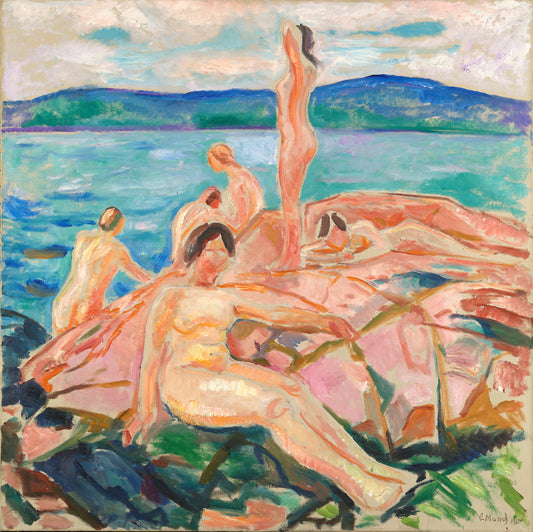Edvard Munch
Mother and daughter
Mother and daughter
Couldn't load pickup availability
High-quality reproductions from the National Museum's collection. Posters by DAIDDA are printed on Litho White Matt - 230 gram photo paper in premium quality. Artprints by DAIDDA provide outstanding colors, sharpness and durability in museum quality - printed on Moab Entrada Natural 300 gram cotton art paper. Printed on a matte surface with scratch-resistant pigment ink.
About the original:
Date: Probably 1897
Other titles: Mother and Daughter (ENG)
Designation: Painting
Material and technique: Oil on canvas
Technique: Oil
Material: Canvas
Dimensions: 135 x 163 cm
Subject: Visual arts
Classification: 532 - Visual arts
Subject type: Portrait
Acquisition: Gift from Olaf Schou 1909
Inventory no.: NG.M.00840
Part of exhibition: Edvard Munch, 1983 - 1984
Ausstellung Edvard Munch, 1954
MUNCH! Nietzsche, Thiel and the Nordics' greatest artist, 2013
The Free Exhibition, 1898
Funen Stiftsmuseum's Edvard Munch exhibition, 1955
Ausstellung Edvard Munch, 1955
Edvard Munch, 1958
Edvard Munch, 1987
The Art Association's Edvard Munch exhibition, 1955
Edvard Munch, 1998
Olaf Schous's gifts to the National Gallery, 1987 - 1988
Munch e lo spirito del Nord. Scandinavia nel secondo Ottocento, 2010 - 2011
Munch 150, 2013
Edvard Munch, 1927
Edvard Munch - Archetypes, 2015 - 2016
Registration level: Single object
Owner and collection: The National Museum of Art, Architecture and Design, Visual Art Collections
Photo: Høstland, Børre
Shipping and returns
Shipping and returns
Shipping: We deliver to Scandinavia, the EU, the USA and several other countries. Please contact us if your country is not listed and we will try to arrange delivery.
Delivery time: 2-5 days within Norway, 7 days in Europe, 14 days globally.
Packaging: Our products are made to order and sent rolled in environmentally friendly packaging.
Customs Fees: International orders may be subject to customs fees, which are not included in shipping costs.
Return policy: You can return images within 14 days. See our returns page for more information.
Secure Payment: We never store your payment details. See our privacy policy for details.

See all works
-
Bathing man
Vendor:Edvard MunchRegular price From 150,00 NOKRegular priceUnit price per -
High summer
Vendor:Edvard MunchRegular price From 150,00 NOKRegular priceUnit price per -
Rue Lafayette
Vendor:Edvard MunchRegular price From 150,00 NOKRegular priceUnit price per -
Flower meadow at Veierland
Vendor:Edvard MunchRegular price From 150,00 NOKRegular priceUnit price per

Edvard Munch
Edvard Munch worked as an artist for over sixty years. He was creative, ambitious and hardworking. He made close to two thousand paintings, hundreds of graphic motifs and thousands of drawings. In addition, he wrote poems, prose and diaries. Scream, Madonna, Death in the sick room and the other symbolist images from the 1890s have made him one of the most famous artists of our time.
"Don't become an artist!" Edvard wanted to become an artist early on, and there was no doubt that he had talent. But his father refused to allow him to follow his dream, and Edvard therefore began studying to become an engineer. But after just one year, he chose to defy his father, and changed the engineering school to the Royal School of Design in Kristiania. Talented and provocative bohemian It was obvious to everyone in the Norwegian art community that the young man was a rare talent. In 1883, aged 20, he made his debut at the Autumn Exhibition. In 1886, Munch became acquainted with the writer and anarchist Hans Jæger, the leader of Kristiania-bohemen. The bohemian milieu convinced Munch that art had to renew itself in order to reach people, and to mean something in their lives. In the same year, he exhibited the painting The Sick Child. It created debate! Courage led to a breakthrough. Some said that The Sick Child was brilliant, while others thought it was unfinished and that it had nothing to do at an exhibition. Today this is considered Munch's breakthrough. Here he showed independence and a willingness to take new paths.
With one key word, we can say that his artistry from here until his last brush stroke is characterized by experimentation. Munch did not care about established "rules" for so-called good art. His techniques in both painting and graphics were innovative. From man's emotional life, to agriculture and landscape Henrik Ibsen's dramas about man's existential challenges inspired Munch. Themes such as death, love, sexuality, jealousy and anxiety were central to his early pictures. Some themes sprung from personal experiences. For example, Death in a hospital room and The sick child can be linked to his recollection of his mother's and sister's illness and early death. After 1910, Munch chose a quieter and more withdrawn life. With his own farm both at Ekely and in Hvitsten, he found completely new motifs, such as agriculture, working life and landscape. The man in the cabbage field is a typical example from this time.





